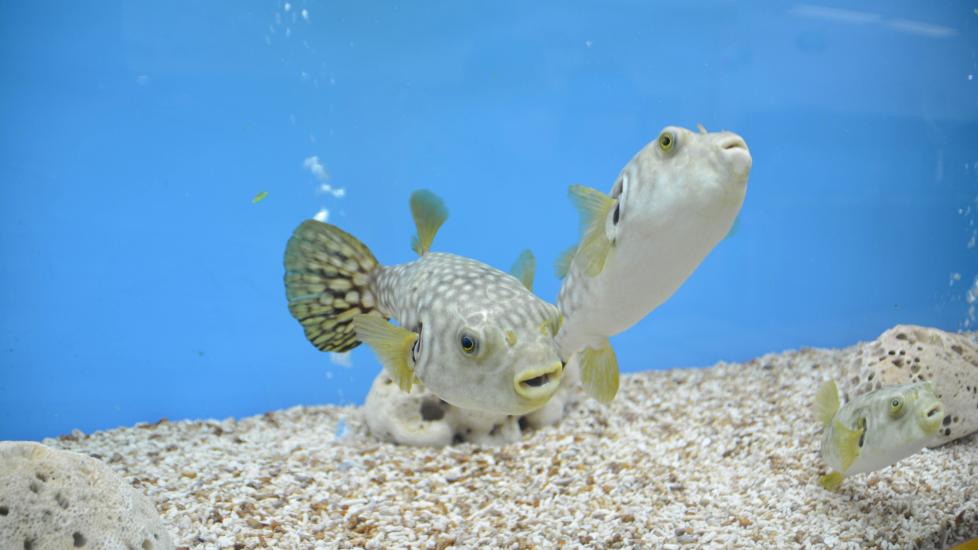6 Fun Facts About Puffer Fish
Warisara Pearprai/iStock / Getty Images Plus via Getty Images
Puffer fish are well-known for their ability to puff themselves up. This defense tactic involves sucking water into their stomach, rendering them too large for predators to eat. Yet, the intrigue surrounding puffer fish goes far beyond their inflating skills.
We took a deep dive with expert fish curators to explore six fun facts about puffer fish.
1. There Are Over 190 Different Species of Puffer Fish
Most puffer fish species are round in shape, but a few are more box-like, says Lizeth Webster, curator of fish and invertebrates at the Long Island Aquarium. If you have a saltwater aquarium, there are plenty of puffer fish species to choose from because most puffers thrive in saltwater. In comparison, there are less than 30 species of freshwater puffer fish.
2. Puffer Fish Don’t Have Scales … or Spines
Puffers are relatives of the spiny porcupinefish. However, where the two species differ is that porcupine fish are covered in spines.
“Puffers in fact do not have spines [or scales] on their bodies,” says Webster. “They have rough, textured flesh.” When it comes down to it, though, the spines of porcupine fish and the rough skin of puffers serve as good protection.
3. Puffer Fish Have Teeth
Puffer fish have two upper teeth and two lower teeth, both sets fused together to form a pointed beak-like structure. But they’re no ordinary teeth—puffer fish teeth form an overbite and continuously grow without routine care.
“To keep their teeth healthy and prevent them from overgrowing, puffers and porcupine fish chew on hard structures like clam shells or shellfish that naturally trim their teeth,” explains Webster. When they’re not fed a diet that includes hard substrates, a puffer fish’s teeth eventually become too large, which prevents them from properly opening their mouths.
Wild puffer fish eat crustaceans and bivalves, such as crabs, shrimp, and mollusks. In home tanks, puffers are commonly fed prepared diets like fish meal-based pellets.
While convenient, a diet of pellets alone can lead to tooth and lead them to gnaw on aquarium decor. Therefore, Webster recommends adding frozen shrimp and clams or snails to your puffer’s diet.
Puffer fish have two upper teeth and two lower teeth, both sets fused together to form a pointed beak-like structure.
Just as intriguing as what puffer fish eat is how they eat it. “Many people who keep large puffers at home often hand-feed them,” says Nathan Farnau, curator of fishes and invertebrates at the Georgia Aquarium.
You can also feed your puffer fish live food to give them something to chase. They’re not the fastest swimmers, but they’re agile. Just be sure to keep live food in a separate tank for quarantine before feeding them to your puffer fish.
5. Puffer Fish Are Poisonous
Puffer fish are indeed poisonous and some even pose a lethal threat if eaten or touched.
All puffer fish have a chemical called tetrodotoxin in their liver, sex organs, and skin, although some species of puffers are more toxic than others. According to the Centers for Disease Control and Prevention (CDC), tetrodotoxin is an “extremely potent poison” that causes paralysis of the muscles. Webster says the northern puffer fish is among the few species with minimal levels of tetrodotoxin.
In general, handling most fish is not recommended because it can stress them out and disrupt their immune system. However, if you must handle your puffer fish, “always wear latex gloves and use a hard container that can accommodate a puffed-up fish,” says Webster. Never ingest aquarium water and ensure other pets can't access it.
6. Puffer Fish Require an Experienced Pet Parent
Puffer fish may not be the ideal fish for beginner aquarists. Farnau describes puffer fish as “very high maintenance.” Here are some important care considerations to keep in mind before bringing a puffer fish home:
-
They require a specially tailored habitat. Puffers do best in an interactive habitat with caves, arches, and plenty of sturdy structures they can chomp on. Webster says that while coral tanks are nice to look at, puffer fish will simply decimate the structures.
-
You might need a bigger aquarium than you think. Puffer fish come in a surprising range of sizes. There are minuscule 1-inch cuties like the pea puffer, which require a 20-gallon tank for exploration. Then, there are the giants like the Mbu puffer, which can exceed a whopping 2 feet in length and require much larger tanks. Thoroughly research the mature size of your ideal puffer fish species and purchase an appropriately sized tank for their adult size; these fish continue growing even if the tank is too small.
-
You’ll need a top-notch filtration system. Puffers are notoriously messy eaters. It’s recommended to remove any uneaten bits of food after mealtime to help keep the water clean. Even with the best filtration system, expect to clean your filter often and change your puffer’s water frequently.
-
Always commit to a pet for the span of their life. The lifespan of a puffer fish in captivity averages about 10 years, depending on the species. Farnau urges pet parents to "never acquire a fish without the commitment to meet [their] long-term needs.”
